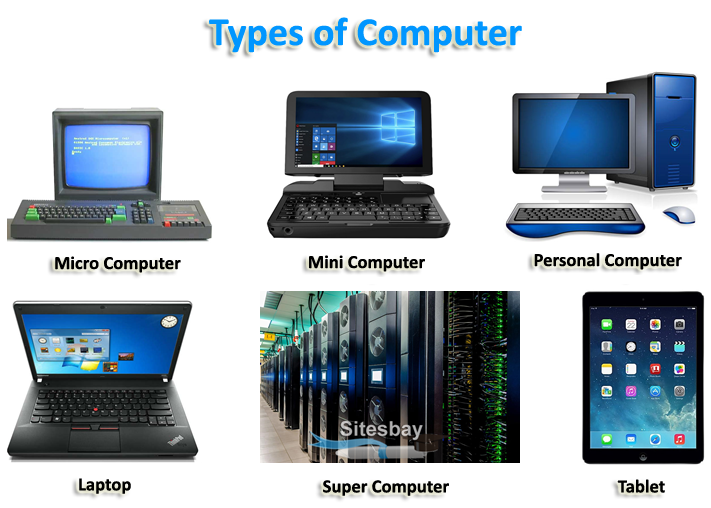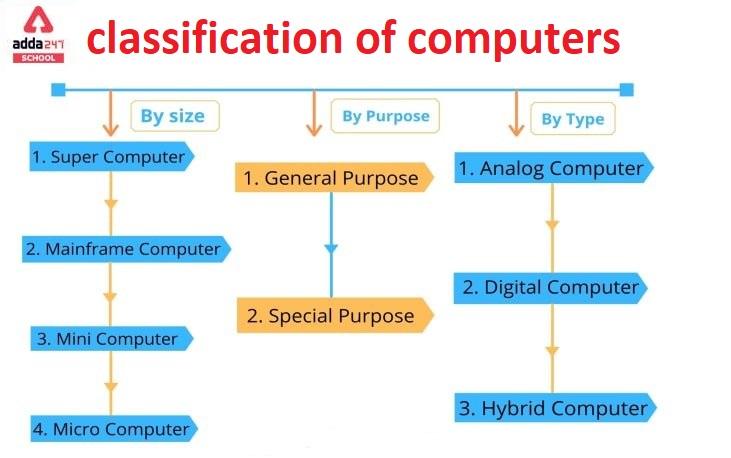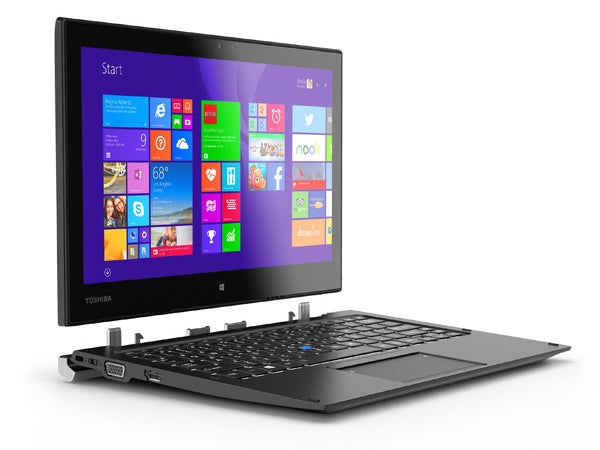What are Types of Computers?
A computer is an electronic device, operating under the control of instructions stored in its own memory, that can accept data (input), process the data according to specified rules, produces information (output), and keep the information for future use. The computer contains many electronic and mechanical components known as hardware.
There are several bases of classification of computers that we explained below.
Electronic components in computers process data using instructions, which are the steps that tell the computer how to perform a particular task. Software or a program is a collection of related instructions organized for a common purpose.
One popular category of computer is the personal computer. A personal computer (PC) is a computer that can perform all of its input, processing, output, and storage activities by itself. Types of personal computers include laptops, tablets, and desktops.
Laptops and tables are sometimes called mobile computers. A mobile computer is a portable personal computer, designed so that a user can carry it from place to place.
Classification of Computers
We can classification of computers on the basis of purpose, the technology used, and size and capacity. Following are the classification of computers:
- General Purpose Computers
- Special Purpose Computers
- Analog Computer
- Digital Computer
- Hybrid Computers
- Super Computer
- Mainframe Computer
- Mini Computer
- Micro Computer
- Tower Model Computer

According to Purpose
According to the utilization of computers for different uses. Following are the classification of computers on basis of purpose:
General Purpose Computers
Computers that follow instructions for general requirements such as sales analysis, financial accounting, invoicing, inventory, management information, etc. are called General Purpose Computers. Almost all computers used in offices for commercial, educational, and other applications are general-purpose computers.
Special Purpose Computers
Computers designed from scratch to perform special tasks like scientific applications and research, weather forecasting, space applications, medical diagnostics, etc. are called Special Purpose Computers.
According to Technology Used
These are the classification of computers on basis of the technology used:
Analog Computer
Analog computers are special purpose computers that represent and store data in continuously varying physical quantities such as current, voltage, or frequency. These computers are programmed for measuring physical quantities like pressure, temperature, speed, etc, and to perform computations on these measurements.
Analog computers are mainly used for scientific and engineering applications. Some of the examples of analog computers are given below:
- Thermometer: It is a simple analog computer used to measure temperature. In a thermometer, the mercury moves up or down as the temperature varies.
- Speedometer: The car’s speedometer is another example of an analog computer where the position of the needle on the dial represents the speed of the car.
Digital Computer
Digital computers are mainly general-purpose computers that represent and store data in discrete quantities or numbers. In these computers, all processing is done in terms of numeric representation (Binary Digits) of data and information.
Although the user enters data in decimal or character form, it is converted into binary digits (0’s and l’s). Almost all the computers used nowadays are digital computers and we will discuss the detailed working and components of these computers in subsequent sections of this unit.
Hybrid Computers
Hybrid computers incorporate the technology of both analog and digital computers. These computers store and process analog signals which have been converted into discrete numbers using analog-to-digital converters.
They can also convert digital numbers into analog signals or physical properties using digital-to-analog converters. Hybrid computers are mainly used in artificial intelligence (robotics) and computer-aided manufacturing (e.g. process control).
According to Size and Capacity
Computers vary widely in performance, size, and cost. Performance is measured in terms of speed of processing instructions, storage capacity, ability to handle a large number of input and output devices, and nature of operations performed (simple word processing to complex scientific calculations). Generally, the better the performance, the larger the size and the higher the cost.
According to the size and memory/storage capacity. Following are the types of computers according to size:
Super Computer
Complex scientific applications like weather forecasting require a large amount of data to be manipulated within a very short time. Other uses of supercomputers are scientific simulations, animated graphics, fluid dynamic calculations, nuclear energy research, electronic design, and analysis of geological data.
Large supercomputers with faster processing using multiple processors and superior technology are used for complex tasks requiring a lot of computational power. Perhaps the best-known supercomputer manufacturer is Cray Research. Examples of supercomputers are CRAY XMP-24 and NEC-500.
A supercomputer is a biggest and fastest computer, which is mainly designed for complex scientific applications. It has many CPUs (Central Processing Units) the main part of the computer) which operate in parallel to make it the fastest computer. It is typically used for the following applications:
- Weather Forecasting
- Petroleum Exploration and Production
- Energy Management
- Defense
- Nuclear Energy Research
- Structural Analysis
- Electronic Design
- Real-time Animation
- Medicine
Mainframe Computer
The earliest computers were called mainframes due to their large size. A mainframe is the heart of a network of computers or terminals which allows hundreds of people to work at the same time on the same data. It requires a special environment cold and dry.
Mainframes are very large computers with a very high capacity in the main store. Because they can process large amounts of data very quickly, they are used by big companies, banks, and government departments as their main computer. They can be linked into a network with smaller department computers, microcomputers, or with each other.
Mainframe computers are very large and fast computers but smaller and slower than supercomputers. These are used in a centralized location where many terminals (input/output devices) are connected with one CPU and thus, allow different users to share the single CPU.
They have a very high memory (several hundred Megabytes) and can support thousands of users. They are mainly used for the following applications:
- Railway and Airline Reservations
- Banking Applications
- Commercial Applications of Large Industries/Companie
Some of the examples of mainframe computers are IBM 3090, IBM 4381, IBM 4300, and IBM ES-9000.
Mini Computer
A mini computer is a class of multi-user computers that lies in the middle range of the computing spectrum, in between the mainframe and microcomputers. It is less powerful than a mainframe and more powerful than microcomputers. They have larger RAM and backing storage capacity and can process data more quickly.
Some examples of minicomputers are PDP-1, IBM AS/400, and DEC Micro VAX. IBM AS/400, which is actually a minicomputer (computer with performance between a mainframe and minicomputer) is becoming very popular among minicomputers.
Micro Computer
Microcomputers are at the lowest end of the computer range. The term “microcomputer” was introduced with the advent of single-chip microprocessors. ‘Personal Computer (PC)’ was first known as a microcomputer because they are designed to be used by one person at a time.
The principal characteristics of personal computers are that they are single-user systems and are based on microprocessors. However, although personal computers are designed as single-user systems, it is common to link them together to form a network.
A personal computer may be a desktop computer, a laptop, a tablet PC, or a handheld PC (also called a palmtop). Personal computers are typically used at home, at school, or at a business.
The most common applications for businesses, the PC is used for word processing, spreadsheet calculating, and database managing. At home, the PC is for entertainment (computer games) and surfing the Internet and e-mail.
The other applications are desktop publishing, accounting, statistical analysis, graphics, investment analysis, project management, editing photographs, creating graphics, and also used in teaching (the computer acts as a teacher). The highly visible personal computers fall under these categories:
- Tower Model Computer, Desktop
- Laptop or Notebook, Sub-notebook
- Palmtop, Personal Digital Assistant (PDA), Pocket PC, Tablet PC
- Ultra-Mobile PC (UMPC), Home Theater PC (HTPC)
- Workstation/Server Computer, Client-Server Computer
- Embedded Computer, Wearable Computer
Tower Model Computer
A PC in which the power supply, motherboard, and mass storage devices are stacked on top of each other in a cabinet. This is in contrast to desktop models, in which these components are housed in a more compact box.
The main advantage of tower models is that there are fewer space constraints, which makes the installation of additional storage devices easier.
FAQ Related to Classification of Computers
What is the classification of computers?
There are several bases of classification of computers that we explained below:
1. General Purpose Computers
2. Special Purpose Computers
3. Analog Computer
4. Digital Computer
5. Hybrid Computers
6. Super Computer
7. Mainframe Computer
8. Mini Computer
9. Micro Computer
10. Tower Model Computer.
What are the types of computers?
Following are the types of computers:
1. General Purpose Computers
2. Special Purpose Computers
3. Analog Computer
4. Digital Computer
5. Hybrid Computers
6. Super Computer
7. Mainframe Computer
8. Mini Computer
9. Micro Computer
10. Tower Model Computer.

